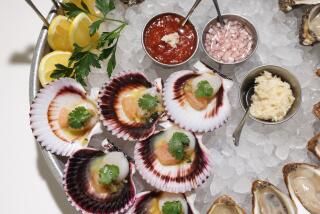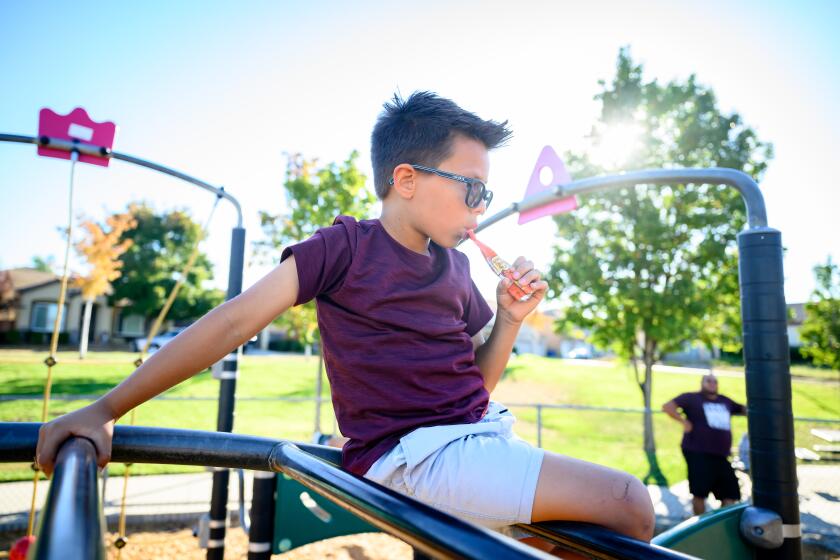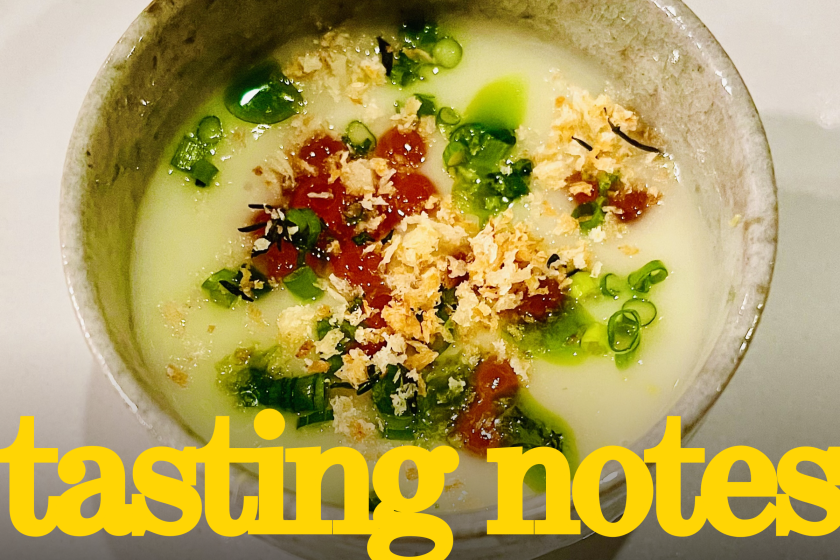It’s a Rose Future
Two decades ago, winemakers claimed rose was the wine that went with everything. In truth, they made the wine so clumsily and from such poor-quality grapes that it went with nothing. Sweetish, off-tasting wine all but killed rose’s reputation among serious wine drinkers.
With time, however, grapes and wine-making techniques have improved. In the last decade, rose--some rose, anyway--has become great wine.
When made dry or nearly dry, rose has enough flavor to match a huge array of foods, so it’s excellent when one person orders beef and the other sole. It has flavor enough to parry with hors d’oeuvres or after-dinner cheeses.
Moreover, it can be made less expensively than most other wines, since it needs no expensive oak barrels for aging and is best served young. In fact, the younger and fresher, the better.
*
But rose is still not a wine that sells itself. A spot check of Southern California restaurants and wine shops suggests that where the staff recommends rose, it’s selling well--”going through the roof,” in one wine salesman’s words. On the other hand, a store owner reports that where customers don’t get a sales pitch, rose doesn’t even rank as a category. Another store owner says if he knows customers are adventuresome, he’ll recommend a rose, confident that they’ll come back for more.
One South Bay restaurant says it has been selling a lot of 1992 Chateau de Tigne ($10)--a rose made by a winery owned by French film star Gerard Depardieu--but only since personnel started pushing the wine. “A few weeks after we started talking about it,” says the wine buyer, “it’s all people would order.”
Just five years ago, I would have had a difficult time assembling a dozen roses to evaluate. In a recent series of tastings, though, I easily got my hands on two dozen. (Admittedly, many are not widely available--few of the wines below are available in supermarkets; fine wine shops are a better bet. Some of the wines may even need to be ordered from the winery.)
One factor that makes many of these wines better than the roses of the past is much better grapes. Another is improved technology. In the past, many roses were fermented in concrete vats, where the wines got too hot and developed a faint orange color and an aroma of wet cardboard or paste. Today, virtually every major winery has stainless-steel tanks that may be chilled to allow more precise fermentation, which retains the fruit of the grape.
*
California winemakers have also begun to adopt a French wine-making technique called saignee , which consists of drawing off some of the juice from a vat of red wine that has just started fermenting, before the grape skins can give their color and flavor to the entire tank. Originally, this was a way of concentrating a red wine--say, a Pinot Noir--and the clear juice that was drawn off would be discarded or made into an everyday wine for the employees. These days, the juice is removed when it’s pink, piped to stainless-steel tanks and carefully vinified into a rose, so the winemaker gets two wines from his grapes: a concentrated red and a well-made rose.
This so-called rose de saignee has been used successfully by Jim Clendenin for his excellent 1993 Au Bon Climat Vin Gris ($7.50) and by Tony Soter for his stunning 1993 Etude Rose of Pinot Noir ($10.50).
Rose may also be made by the traditional method of blending lighter red wine grapes and removing the entire contents from the vat before the skins impart much color. One superb example of this technique is 1993 Navarro Vineyards “Petites Villages” ($8.50), a wine that is half Grenache with smaller amounts of Zinfandel, Pinot Noir and Gamay.
Navarro winemaker Jim Klein makes his wine darker than most roses, but it is not yet red. The wine’s strawberry and pepper/spice characteristics make it a joy when served chilled, either as an aperitif or with any food. The wine may be ordered for $59 for six bottles, including shipping and tax, from (800) 537-9463.
*
Arriving in Los Angeles next week will be a delightful new wine from the south of France made by the saignee process: 1993 Val Joanis Rose ($7). This Syrah-based wine has a deep, flavorful cherry/pepper aroma and crisp, light taste.
In October, a wine called 1993 Vin Gris de Triennes ($8) will be available. The wine is a joint venture of two famed Burgundian producers, Jacques Seysses of Domaine Dujac and Aubert de Villaine of Domaine de la Romanee-Conti, who co-own a 138-acre estate in Provence. This wine will be reviewed separately in a few weeks.
Other roses I love include the superb 1993 Joseph Phelps Vineyards Grenache Rose “Vin de Mistral” ($9.50); 1993 Les Jamelles Cinsault ($7); 1993 Bonny Doon Vineyards “Vin Gris de Cigare, Pink Wine”; 1993 Sanford Vineyards “Vin Gris” ($8); Saintsbury “Vincent Vin Gris” ($8); and 1993 Il Podere dell’Olivos “Moana Arrossisce” ($10), a Barbera-based wine by Clendenin.
Also worth trying: a totally dry Spanish rose called 1993 Muga Rose ($7). It is made essentially of Grenache grapes (known in Spain as Garnacha).
*
Berkeley importer/merchant Kermit Lynch has noticed a significant uptick in rose sales, especially in his top two French roses. The hottest is 1993 Domaine de Fontsainte “Gris de Gris” ($7.50), a Corbieres from Languedoc. Also excellent is Lynch’s 1993 Chinon Rose from Charles Joguet ($11.50), which is all Cabernet Franc. Some Los Angeles-area wine shops and restaurants carry Lynch’s wines.
Also interesting, though not as fruity or complex as the preceding wines, is the non-vintage Mouton-Cadet Rose ($7).
Rose is best served chilled, but the better ones work well if only slightly cool. And if the glass gets too warm and no ice bucket is handy, just toss in a couple of ice cubes.
As for those other roses, I figure the term “blush” refers to the embarrassment winemakers feel when they make these insipid, sweetish wines whose main virtue is wetness.
More to Read
Eat your way across L.A.
Get our weekly Tasting Notes newsletter for reviews, news and more.
You may occasionally receive promotional content from the Los Angeles Times.










